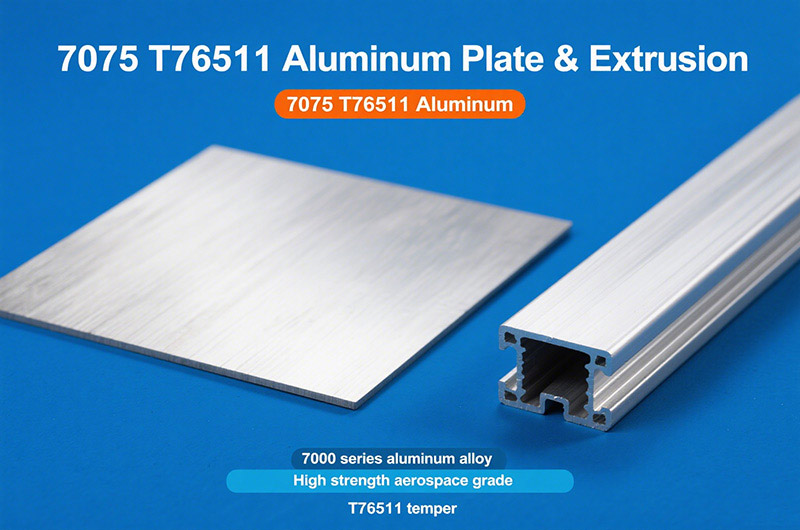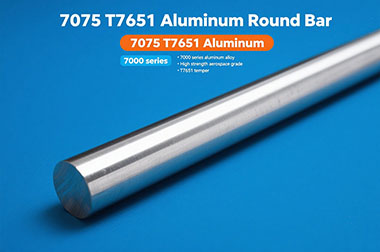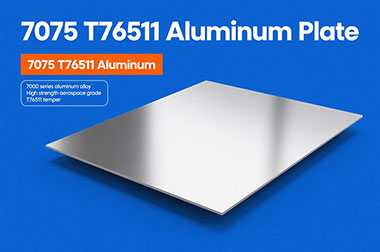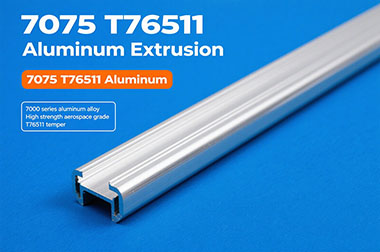7075 T7651 Aluminum
As a high-strength, medium-toughness aluminum alloy, 7075-T7651 possesses excellent comprehensive properties and broad application prospects. Its perfect combination of high strength and lightweight characteristics makes it widely used in aerospace, national defense and military, transportation, and other fields.
7075 T7651 is a heat treatment temper of 7075 aluminum alloy, achieved through solution heat treatment, stress relieving, and artificial overaging. 7075 T7651 belongs to the overaged temper, which enhances its corrosion resistance—especially exfoliation corrosion resistance—and features specific manufacturing processes and performance characteristics.
- "T" indicates the heat treatment temper.
- "7" indicates overaging treatment.
- "6" indicates specific overaging process parameters.
- "51" indicates stress relief by stretching.
Compared with the T6 temper, the main feature of the T7651 temper is slightly reduced strength, but with significantly improved exfoliation corrosion resistance and stress corrosion cracking resistance, along with better dimensional stability and post-machining deformation control.

7075 T7651 Characteristics
- Outstanding strength performance: This alloy has a clear advantage in balancing strength and weight, making it well-suited for manufacturing components that require both lightweight properties and the ability to withstand high stress.
- Stress corrosion resistance: In the T7651 temper, it exhibits better resistance to stress corrosion cracking—a common concern for high-strength aluminum alloys.
- Excellent fatigue strength: In this temper, it also shows strong resistance to repeated loading and unloading cycles, meaning good fatigue performance.
- Moderate corrosion resistance: Although its corrosion resistance is not as high as that of some other aluminum alloys, it can be further improved through surface treatments such as anodizing.
- Welding difficulty: The welding process for 7075-T7651 presents certain challenges, so mechanical fastening methods such as riveting or bolted connections are usually preferred for joining.
7075 T7651 Aluminum Chemical Composition
| Element | Percentage |
| Al | 90 |
| Cr | 0.18 - 0.28 |
| Cu | 1.2 - 2 |
| Fe | 0.5 max |
| Mg | 2.1 - 2.9 |
| Mn | 0.3 max |
| Si | 0.4 max |
| Ti | 0.2 max |
| Zn | 5.1 - 6.1 |
| Zr+Ti | 0.25 max |
7075 T7651 Aluminum Mechanical Properties Data Sheet
| Property | Metric Value | Imperial Value |
| Brinell Hardness | 150 HB | - |
| Elastic Modulus (Young's) | 70 GPa | 10 × 10⁶ psi |
| Poisson's Ratio | 0.32 | - |
| Shear Modulus | 26 GPa | 3.8 × 10⁶ psi |
| Tensile Strength: Ultimate | 550 MPa | 80 × 10³ psi |
| Tensile Strength: Yield | 470 MPa | 68 × 10³ psi |
| Shear Strength | 320 MPa | 47 × 10³ psi |
| Fatigue Strength | 190 MPa | 27 × 10³ psi |
| Elongation at Break | 7.3% | - |
7075 T7651 Aluminum Physical Properties
| Physical Property | Value | Unit |
| Density | 2.80-2.81 | g/cm³ |
| Melting Point Range | 490-635 | ℃ |
| Coefficient of Thermal Expansion (20-100℃) | 23.5-23.6 | μm/m·K |
| Thermal Conductivity | 130-150 | W/m·K |
| Electrical Conductivity | 41-43 | %IACS |
| Specific Heat | 0.960 | J/g·℃ |
7075 T7651 Aluminum Corrosion Resistance
Corrosion resistance is one of the important characteristics of the 7075-T7651 alloy. Although the overall corrosion resistance of the 7000 series aluminum alloys is not as good as that of the 6000 series, with proper heat treatment and surface treatment, the 7075-T7651 alloy can achieve good corrosion resistance.
The T7651 temper is an overaged condition, achieved through a specific heat treatment process that allows the alloy to maintain high strength while improving its corrosion resistance, especially its resistance to exfoliation corrosion and stress corrosion cracking.
7075 T7651 Product Forms and Specifications
- 7075 T7651 Plate: Typically over 6 mm in thickness, widely used in aerospace structural components, high-strength mechanical parts, and molds.
- 7075 T7651 Heavy Plate: Typically between 12.7–25.4 mm in thickness, or even thicker, mainly used for structural components requiring high strength and high rigidity.
- 7075 T7651 Extrusion: Products with various cross-sectional shapes produced through the extrusion process, widely used in aerospace structures, architectural structures, and special mechanical parts.
- 7075 T7651 Forging: High-strength parts produced through forging processes, with excellent mechanical properties and reliability, suitable for critical components under high stress and dynamic load conditions.
- 7075 T7651 Rod and Bar: Diameter typically between 4–410 mm, used to manufacture high-strength bolts, rivets, and other mechanical parts.
7075-T76511 Plate Specifications
In the 7075-T7651 alloy product range, plates in the T76511 temper have specific specifications and application characteristics.
| Parameter | Value Range | Unit |
| Thickness | 6.0-50.0 | mm |
| Width | 1000-2500 | mm |
| Length | 2000-6000 | mm |
| Typical Width | 1000, 1250, 1500 | mm |
| Typical Length | 2000, 2500, 3000 | mm |
7075-T76511 Extrusion Specifications
7075-T76511 extrusion profiles are another important product form, featuring a variety of cross-sectional shapes and size specifications.
| Parameter | Value Range | Unit |
| Minimum Size for Open Profiles | 4×3 | mm |
| Maximum Size for Open Profiles | 850×50 | mm |
| Minimum Size for Closed Profiles | 6.35×1 | mm |
| Maximum Size for Closed Profiles | 573×10 | mm |
| Weight Range per Meter | 0.03-124 | kg/m |
7075 T7651 Applications
Aerospace Field
- Aircraft structural components: wings, fuselage, tail
- Spacecraft components: satellite structural frames, rocket structural parts
- Aircraft interiors: floor structures, ceiling structures
- Landing gear structures: support structures and door structures
Defense and Military
- Armor protection systems: lightweight armor plates, bulletproof structures
- Military vehicle structures: tanks, infantry fighting vehicles
- Weapon system components: artillery systems, missile launch systems
- Naval vessel structures: superstructures, shipborne weapon systems
Transportation
- Rail transit: high-speed train structures, subway vehicles
- Automotive industry: high-performance automotive structural parts, safety components
- Shipbuilding and marine engineering: ship superstructures, offshore platforms
- Bicycles and sports equipment: high-performance bicycle frames, sports gear
Industrial and Civil
- Mold manufacturing: injection molds, die-casting molds
- Precision machinery and equipment: industrial robot structures, automation equipment
- Construction and decoration: building structures, decorative materials
- Medical equipment: medical device structures, surgical instruments
Performance Comparison of 7075-T7651 and Other Tempers of 7075
The 7075 aluminum alloy is available in a variety of heat treatment tempers, such as T6, T651, T7351, T76, and T7651, each with its unique performance characteristics. The following is a comparison of the performance of 7075-T7651 with other major tempers:
| Performance Parameter | T6/T651 | T7351 | T76 | T7651 |
| Tensile Strength (MPa) | 572 | 469-490 | 510-515 | 503-515 |
| Yield Strength (MPa) | 503 | 427-455 | 440-450 | 414-450 |
| Elongation (%) | 6-8 | 8-10 | 6-8 | 6-8 |
| Brinell Hardness (HB) | 150 | 135 | 150 | 150-175 |
| Exfoliation Corrosion Resistance | Poor | Good | Good | Good |
| Stress Corrosion Cracking Resistance | Poor | Best | Moderate | Moderate |
| Pitting Corrosion Resistance | Moderate | Good | Good | Good |
| Fatigue Strength (MPa) | Approx. 160 | Approx. 150 | Approx. 155 | Approx. 155 |
| Typical Applications | High-strength structural parts | Structures for highly corrosive environments | Structures for moderately corrosive environments | Structures for moderately corrosive environments |
From the table above, it can be seen that the 7075-T7651 temper achieves a good balance between strength and corrosion resistance.
- Compared with the T6 temper, the T7651 temper has slightly lower strength but significantly improved corrosion resistance.
- Compared with the T7351 temper, the T7651 temper has slightly lower stress corrosion cracking resistance but higher strength.
- Compared with the T76 temper, the T7651 temper includes stress-relief treatment, providing better dimensional stability and improved control of post-machining deformation.
In practical applications, the appropriate temper should be selected based on specific requirements.
- For situations requiring high strength and not severely corrosive environments, T6 or T651 tempers can be selected.
- For highly corrosive environments and moderate strength requirements, the T7351 temper can be selected.
- For moderately corrosive environments and moderate strength requirements, T76 or T7651 tempers can be selected.
Comprehensive Performance Comparison and Selection Recommendations
| Alloy Series | Representative Alloy | Strength | Toughness | Corrosion Resistance | Machinability | Weldability | Cost | Typical Applications |
| 7000 Series | 7075-T7651 | Very High | Moderate | Moderate | Moderate | Poor | High | Aerospace structures, high-stress mechanical parts |
| 7000 Series | 7050-T7451 | Highest | Good | Good | Moderate | Poor | Highest | High-end aerospace structures, advanced weapon systems |
| 2000 Series | 2024-T3 | High | Good | Moderate | Good | Moderate | Medium-High | Aircraft structural parts, high-strength bolts |
| 6000 Series | 6061-T6 | Moderate | Good | Good | Good | Good | Medium | General structural parts, building materials, daily-use products |
| 5000 Series | 5052-H32 | Moderate | Good | Excellent | Good | Good | Medium | Pressure vessels, ship structures, chemical equipment |
| 3000 Series | 3003-H14 | Low | Good | Excellent | Good | Good | Low | General structural parts, architectural decoration, cookware |
Based on different application requirements, the following aluminum alloy selection recommendations are provided:
- High strength requirements: Prefer 7000 series alloys (such as 7075-T7651, 7050-T7451) or 2000 series alloys (such as 2024-T3). These alloys have high strength and hardness, suitable for high-stress structures.
- Moderate strength requirements: 6000 series alloys (such as 6061-T6) or 5000 series alloys (such as 5052-H32) can be selected. These alloys have good overall performance and cost-effectiveness, suitable for general structural applications.
- Corrosion resistance requirements: Prefer 5000 series alloys or 6000 series alloys. These alloys have good corrosion resistance and are suitable for marine and chemical environments.
- Machining performance requirements: Prefer 6000 series alloys or 3000 series alloys. These alloys have good machinability and weldability, suitable for complex shapes and structures requiring welding.
- Cost requirements: Prefer 3000 series alloys or 6000 series alloys. These alloys are lower in price and have good cost-performance ratio, suitable for general applications.
- Lightweight requirements: For the same strength requirements, alloys with lower density can be chosen, such as 7050-T7451 (density 2.73 g/cm³) or 6061-T6 (density 2.70–2.72 g/cm³), to achieve lighter structures.
In practical applications, factors such as alloy availability, processing technology, surface treatment, and joining methods should also be considered. A comprehensive evaluation should be carried out to select the most suitable alloy material. For critical structural applications, it is recommended to conduct detailed material testing and evaluation to ensure that the material performance meets the design requirements.







